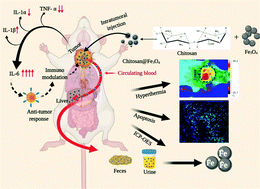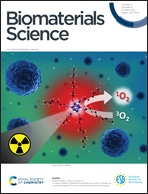Rapid tumor inhibition via magnetic hyperthermia regulated by caspase 3 with time-dependent clearance of iron oxide nanoparticles†
Abstract
Among conventional cancer therapies, radio-frequency magnetic hyperthermia (MHT) has widely been investigated for use with magnetic nanoparticles (MNPs). However, the majority of in vivo biodistribution studies have tested very low MNP dosages (equivalent to magnetic resonance imaging (MRI) applications) to check for clearance rate; which is far below the clinical dose of MHT. Due to this poor validation in preclinical scenarios, quite a few MNPs already in clinical use were later discontinued, on grounds of unexpected clinical outcomes in terms of inflammation, and prolonged clearance in vivo. By exploiting an economical method of synthesis, we have developed chitosan-coated Fe3O4 nanoparticles with high heating efficiency performance. Their anti-tumor response was evaluated in an ectopic tumor model of C6 glioblastoma by MHT. The intratumoral injection of MNPs on days 1 and 7 resulted in rapid tumor inhibition rate of 69.4% within 8 days, with complete inhibition within 32 days, and no recurrence recorded over a 5-month follow-up. Notably, the MNP-mediated MHT therapy achieved the highest degree of therapeutic efficacy required for complete tumor ablation by combining controlled temperature range (<44 °C), reduced MNP dosage; much lower than in most reported studies, and AMF parameters (time of exposure and frequency) within the clinical safety limit. Periodic body weight measurements confirmed negligible adverse side effects in rats. The anti-tumor activity was validated by severe apoptosis (TUNEL, cleaved Caspase-3), reduced proliferation (Ki 67) and disrupted vasculature (CD 31) in the Fe3O4-MHT-treated group. Real-time gene expression of pro-inflammatory cytokines (IL-6, TNF-α, IL-1α, IL-1β) confirmed the intratumoral activation of IL-6, suggesting the role of immunomodulation in triggering the adaptive immune response for faster tumor regression in the treated group. In addition, the biodistribution and clearance rate of MNPs monitored using ICP-OES confirmed their time-dependent biodegradation via excretion (urine, feces), phagocytosis (liver) and circulatory system (blood), with negligible deposition in other major organs (kidney, heart, lungs). Although we could not show complete clearance of our MNPs within the time frame tested, future studies should focus on combining MHT with immunotherapy, and target tumors at a much-reduced iron dose, consequently improving in vivo clearance rate, and hence overcoming the limitations of MHT in clinical therapy.



 Please wait while we load your content...
Please wait while we load your content...